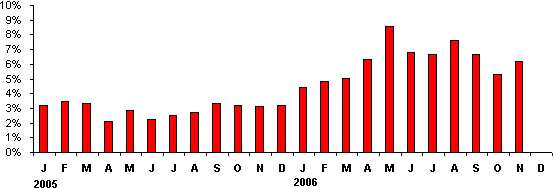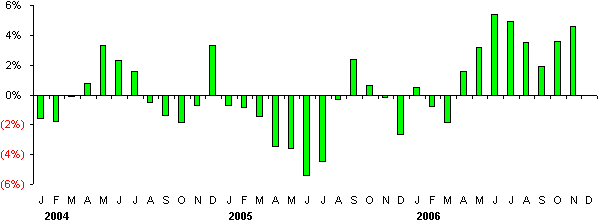IDEX Online Research: Jewelry Price Inflation Intensifies in November
December 26, 06
Jewelry prices in the U.S. surged ahead by nearly 5 percent in November 2006 versus the same period last year. This reverses a trend from prior months in which jewelry price inflation had been easing. The increase in retail jewelry prices was driven largely by a substantial +6.2 percent increase in jewelry producer prices in November.
It is surprising that producer prices flowed through to the retail level so quickly, but margin-pressured suppliers apparently have finally been successful with passing along commodity price increases to their customers.
On a month-to-month basis, diamond prices in November were flat versus October 2006, but precious metals prices were up 5-10 percent in November versus the prior month.
Jewelry Producer Prices Rise in November
After drifting generally downward from a spike in May, jewelry producer prices jumped in November. The Jewelry Producer Price Index rose by 6.2 percent in November, after posting a more moderate 5.3 percent rise in October, but well below May’s peak of 8.3 percent. The U.S. government statistics for Jewelry PPI were recently revised very modestly, but the trend for the year is unchanged – jewelry producer prices have risen dramatically in 2006.
The graph below summarizes the Producer Price Index (including the government’s latest revisions) for jewelry and jewelry products in the U.S. market.
| U.S. Producer Price Index |
Jewelry producer price trends were generally in line with all U.S. producer prices in November, which rose sharply, largely erasing the declines seen in the past couple of months. The government reports that price growth of all categories of finished goods was broad-based, including higher automobile prices during what is normally a slow selling season of the year.
Despite the rise in producer prices in November, overall producer prices (all goods categories) in the U.S. market are up a very modest 0.9 percent year-to-year. In other words, inflation at the producer level remains below historic trends, and this sets the scenario for the possibility of interest rate cuts in 2007.
Retail Jewelry Prices Up in November
Mirroring the jump in producer prices, retail jewelry prices also rose sharply in November. For the month, retail jewelry prices rose 4.6 percent, not far below the peak increase of 5.4 percent (revised) in June.
In part, the price increases may reflect the season of the year: jewelry is a must-purchase item for many men during the Christmas season. In part, it may reflect merchants who are finally passing along cost increases that they incurred earlier in the year. Finally, it likely reflects surging producer prices in November.
The graph below summarizes Consumer Price trends for jewelry in the U.S. market by month for the past two years.
| U.S. Consumer Price Index for Jewelry |
Jewelry retail price trends are counter to retail price trends for all goods. For all practical purposes, aggregate price inflation was flat for “all goods” in the U.S. in November on a seasonally adjusted basis. Analysts are now saying that there is ample evidence that inflation has peaked, and prices may be declining. Energy prices at the retail level rose somewhat in November, but appear to be generally stable.
If these trends hold – producer prices up less than 1 percent for the year and consumer prices flat in November – it is likely that the Fed will hold the Fed Funds rate at 5.25 percent near term, and then begin to reduce rates as early as the spring of 2007.
Jewelry Prices Likely To Stay High
Unfortunately, IDEX Online Research does not see any price relief for jewelry, either at the producer or consumer level. At the producer level, demand from emerging nations for gold, silver, and platinum is surging, especially for uses in electronic equipment and automobiles. That will keep pressure on prices of those commodities. Diamond prices are expected to rise in 2007, despite the prospects of a global economic slowdown. The DTC has cut its ITOs in the first half of 2007 by 15-20 percent from 2006 levels. In part, this will help clear the diamond pipeline of inventory and create some liquidity in the industry, allowing the banks to breathe easier. In part, this will generate scarcity of diamonds and keep prices high.

